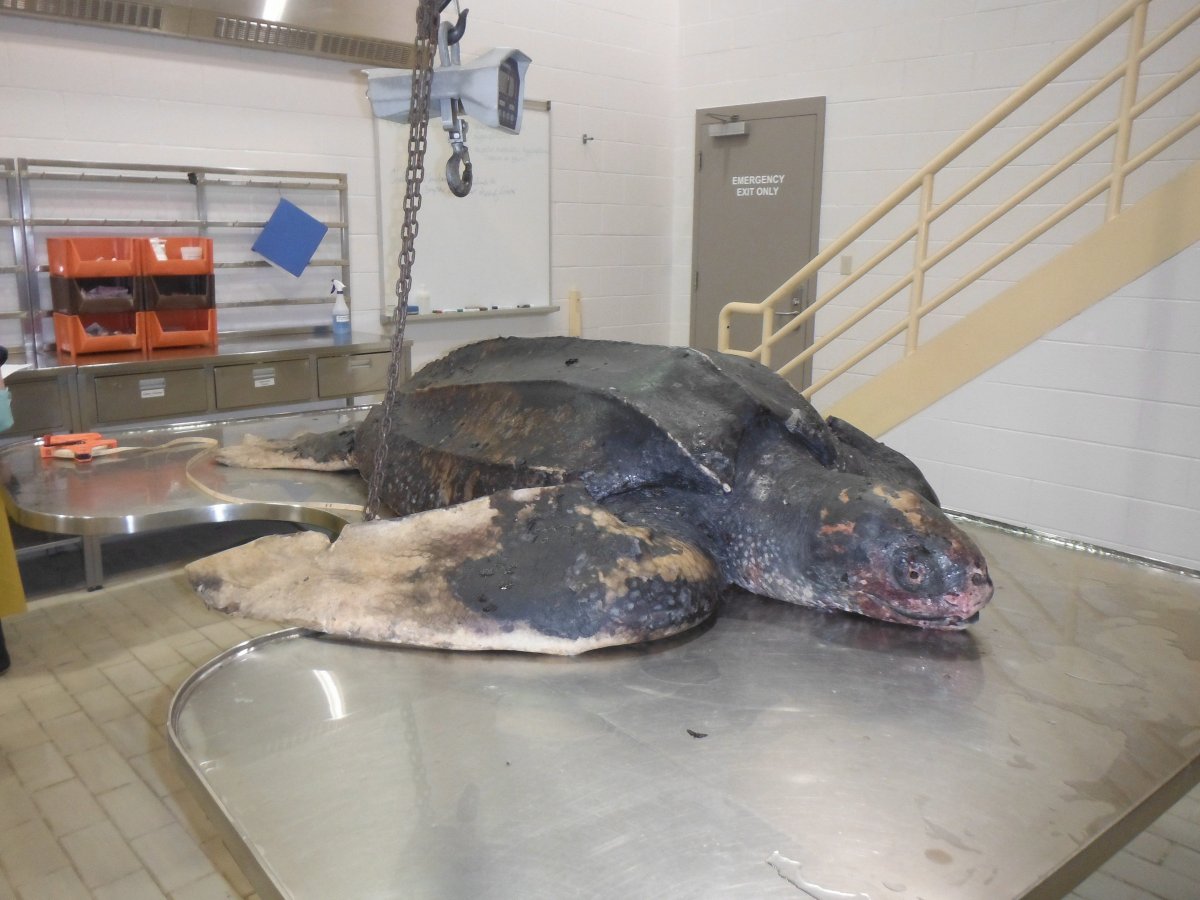The endangered leatherback sea turtle is an elusive creature of the deep.

Last week, however, scientists were stunned when one of these rare, huge reptiles turned up dead in an unlikely place: at the edge of a frozen Cape Breton lake.
Sea turtle biologist Mike James said it’s possible the turtle was following jellyfish – the leatherback’s main source of food – when it entered saltwater Bras d’Or Lake through a narrow channel and later failed to find its way back to the open ocean.
There have been previous eyewitness accounts of leatherbacks in the lake, which is more like an inland sea. But this recent find represents the first time a specimen has been positively identified in the area.
READ MORE: Sea turtle rescued after becoming tangled up in 26 bales of cocaine
“It’s a very significant record for sure,” James said Thursday from the Bedford Institute Oceanography in Halifax.
“It was probably alive pretty late into the year because of the (good) condition of the turtle’s carapace,” he said, referring to the turtle’s thin but tough layer of leather-like skin. The leatherback is the only sea turtle that lacks a hard shell.
Laura Bourque, veterinary pathologist with the Canadian Wildlife Health Co-operative in Charlottetown, performed a necropsy on the animal late Wednesday.
The 360-kilogram turtle – about the size of a grand piano – appeared to be emaciated.
Bourque confirmed there was no other obvious cause of death, though other tests have yet to be completed.
“What it was doing in the Bras d’Or lakes, I really can’t comment on that,” Bourque said in an interview from her lab at the Atlantic Veterinary College.
Samples taken from the turtle’s body will be analyzed for bacteria, parasites and disease.
“It helps us understand what are the threats to these species,” she said.
More often, leatherbacks die when they get entangled in fishing gear or if they eat plastic bags or balloons, having mistaken the trash for jellyfish
Leatherbacks typically avoid narrow inlets, like the ones that connect Bras d’Or Lake to the Atlantic Ocean, James said.
However, unlike other reptiles, they can survive in relatively cold water because they have a thin layer of blubber, similar to marine mammals.
WATCH: Florida wildlife officials rescue hundreds of turtles ‘stunned’ by cold snap

Leatherbacks are summertime visitors to Canada’s Atlantic coast and the Gulf of St. Lawrence, but they typically head south to tropical waters by October.
Given their wide range and elusive behaviour, no one really knows how many there are.
James, who works with the federal Fisheries Department, said the waters along the continental shelf that extends beyond Nova Scotia and southern Newfoundland are prime feeding grounds for leatherbacks.
“They come back to the very same areas to feed every year,” he said.
Researchers in Nova Scotia are leaders in the study of the sea turtles, having started a pioneering satellite-tracking program in 1997.
Leatherbacks can swim up to 12,000 kilometres per season and are known for diving to around 300 metres, though some have reached depths up to 1,200 metres.
At this time of year, the female leatherbacks that feed along Canada’s Atlantic coast are preparing to lay their eggs at beaches that stretch from Florida and the Caribbean to the northeastern edge of South America.
This week, James has been tracking four females that are expected to lay their eggs on the island of Trinidad and along the South American coast.
“They’re a challenging animal to manage and a tricky beast to study,” James said.
The turtles will soon begin their return voyage to Canadian waters, a trip that will see them arrive by the end of June.
- Ontario takes action against chemical plant after Aamjiwnaang First Nation residents fell ill
- High benzene levels detected near Ontario First Nation for weeks, residents report sickness
- Enter at your own risk: New home security camera aims paintballs at intruders
- Beijing orders Apple to pull WhatsApp, Threads from its China app store



Comments